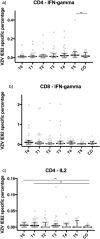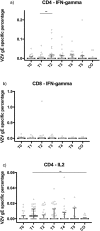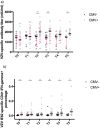Multidisciplinary study of the secondary immune response in grandparents re-exposed to chickenpox
- PMID: 28439065
- PMCID: PMC5430877
- DOI: 10.1038/s41598-017-01024-8
Multidisciplinary study of the secondary immune response in grandparents re-exposed to chickenpox
Erratum in
-
Author Correction: Multidisciplinary study of the secondary immune response in grandparents re-exposed to chickenpox.Sci Rep. 2018 Jul 12;8(1):10824. doi: 10.1038/s41598-018-28930-9. Sci Rep. 2018. PMID: 30002465 Free PMC article.
Abstract
Re-exposure to chickenpox may boost varicella-zoster virus (VZV) immunity in the elderly. This secondary immune response is hypothesized to confer protection against herpes zoster. We longitudinally sampled 36 adults over the course of one year after re-exposure to chickenpox. The resulting 183 samples and those of 14 controls were assessed for VZV-specific T-cell immunity and antibody titres. The percentages of VZV-specific CD4+ IL-2-producing T-cells were increased in re-exposed grandparents compared to control participants up to 9 months after re-exposure. Using a longitudinal mixture modelling approach, we found that 25% and 17% of re-exposed grandparents showed a boosting of VZV-specific CD4+ IL-2-producing T-cells and VZV-specific antibodies, respectively. The antibody boosting occurred exclusively in cytomegalovirus (CMV) IgG-positive participants. CMV IgG-positive participants also had higher VZV IE62-specific CD4+ IFN-γ-producing T-cell percentages and VZV-specific antibody titres. The protective effect of re-exposure to chickenpox is likely limited, as boosting only occurred in 17-25% of the VZV re-exposed grandparents and for less than one year.
Conflict of interest statement
The authors declare that they have no competing interests.
Figures





Comment in
-
VZV-containing vaccines and hospitalization for herpes zoster: careful optimism.Aging Clin Exp Res. 2019 Sep;31(9):1347-1348. doi: 10.1007/s40520-019-01264-w. Epub 2019 Jul 17. Aging Clin Exp Res. 2019. PMID: 31317517 No abstract available.
References
Publication types
MeSH terms
Substances
LinkOut - more resources
Full Text Sources
Other Literature Sources
Medical
Molecular Biology Databases
Research Materials

